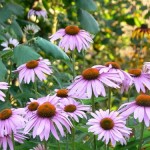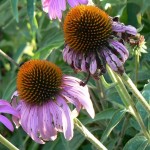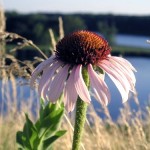Kansas Snake Root – Echinacea angustifolia
|
Current Demand = GOOD |
Parts Used: Herb & Root |
Family: Asteraceae
Common Names: Purple Cone Flower, coneflower, American coneflower…
Description:
Echinacea is a herbaceous perennial and it has a natural range in North America. It grows at a rate of 6-8 inches a year and to a mature height of 12-28 inches. The leaves are dark green and lance-shaped and coarsely toothed. The flowers are cone shaped disks with purple, pale pink, or rarely white. The flowers bloom from June to July and they droop around the center cone. The plant has one or more stems that are mostly unbranched. The Echinacea pallida is an elegant sweet-scented cone flower with long spidery petals.
Growing Region
These plants can be found through out the Midwestern U.S. with heavier growth populations to the west in Texas, Oklahoma and Kansas and north to the Dakotas and Montana. Echinacea augustafolia grows more to the north and pallida grows more to the south. While these plants are similar they each have a separate market value. Your local root buyer can give you pricing details for these two wild plants. Echinacea augustafolia and pallida are more often found growing wild in open woods, fields and prairies. Echinacea plants tend to thrive in large patches throughout dry prairie land with more sun than shade.
Harvesting/Drying
Parts Used: herb and root
For maximum potency Echinacea should be harvested in the late summer and fall after it has time to form mature seed. Both the plant root and herb have market value. Gather the larger more mature plants, leaving plenty of smaller immature plants to seed the area for future harvest. After harvest, separate the herb from the root where they meet at ground level. The roots should be washed in cold water and foreign material (rocks, dirt, and other roots) must be removed. The herb should be kept dry and place out of the sun in a warm area with airflow, such as a barn loft or attic Unless your buyer is purchasing fresh dug roots (which they often do) the clean roots need to be dried. Echinacea root can be dried in the sun although if possible, dry indoors in a well ventilated barn loft or attic to protect from the elements. If natural heat is not available you may need to add heat to a room and a fan for continuous airflow. The key to drying any root, herb or bark is an even combination of heat and airflow. Never dry in an oven or microwave. Once your roots are completely dry (largest root will snap not bend) approximately 5-10 days, depending on the size of the root and drying conditions. Place roots carefully into a cardboard box, paper bag or burlap bag for storage in a dry place until ready to sell or use. Do not store dried herbs or roots in plastic or it will mold.
Planting/Cultivation
Echinacea prefers a well-drained, alkaline soil in sunny locations. Propagation can be from seed or transplants. It is best to start seed on the surface of a soil mix, indoors and move to transplant at 6 weeks old. The seeds germinate in 5-7 days. If started from seed, the first year is sparse, but the second year the plants bloom and become robust.
When the plants are dormant in fall or early spring, the budding rosettes on the crowns can be sliced off or carefully peeled from the main rootstock. Plant them directly. You can get up to seven plants form one root crown. In older plants use a 4-5 inch section of root to propagate new plants.
Attributes (Images)
I, Dy-e [GFDL, CC-BY-SA-3.0 or CC BY-SA 2.5-2.0-1.0], via Wikimedia Commons
By Blaine Hansel (Flickr) [CC BY 2.0], via Wikimedia Commons
 Root Buyer
Root Buyer

